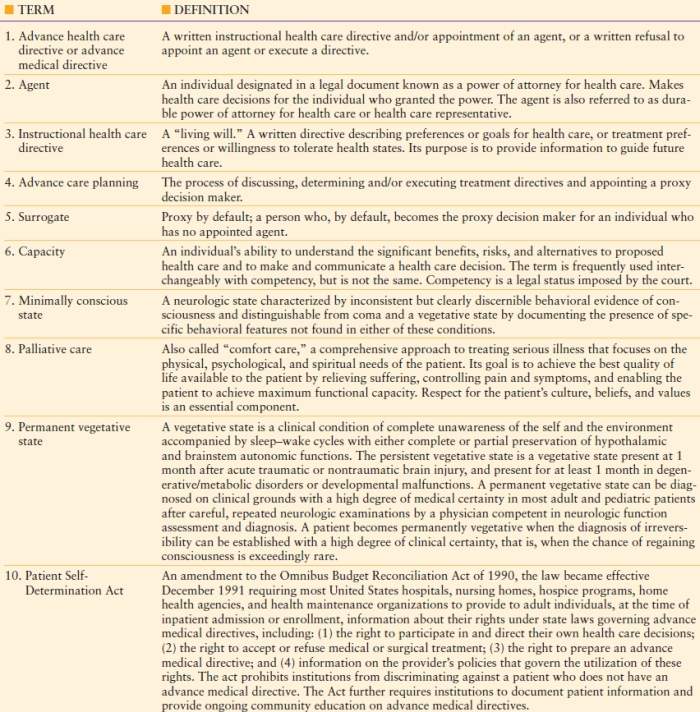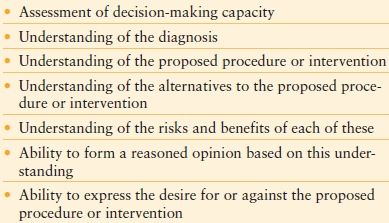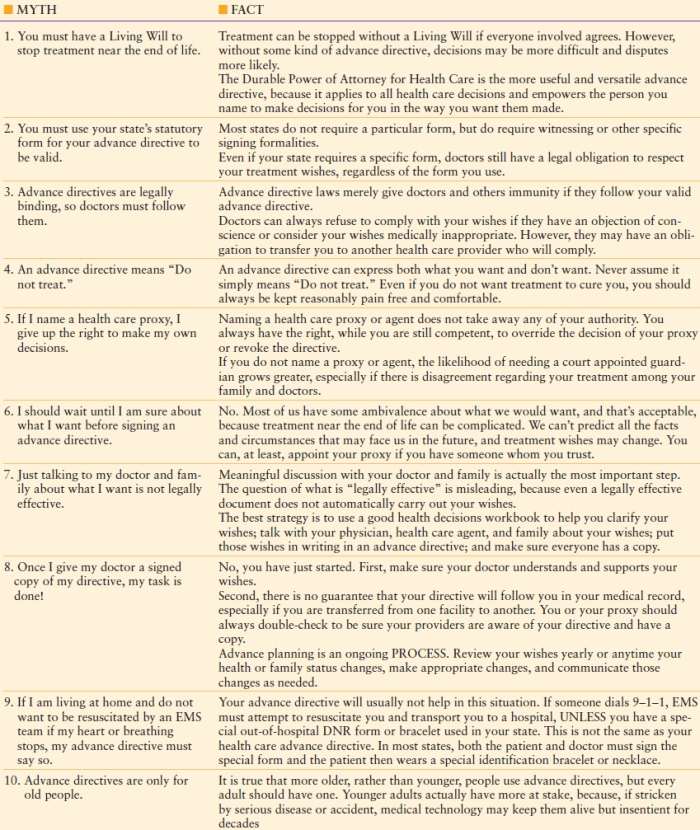
ADVANCE MEDICAL DIRECTIVES
Advances in medical care have led to life-saving interventions, but extending a patient’s life in a severely compromised state may be associated with unnecessary suffering and burdensome financial consequences for the patient, family, and society. Additionally, depending upon the patient’s clinical condition, prognosis, and social circumstances, the patient may not desire certain interventions, especially those that will prolong the dying process. Providing the best, yet appropriate care for a patient near the end of life requires planning and the input of multidisciplinary caregivers within the context of medical ethics principles.
Advance care planning is the process by which a patient, along with his or her physician, family members, or other close personal relations, plans for future medical care.1 Engaging in this process eventually leads to a document called an “advance care directive” or “advance medical directive.” This document provides vital information to help the patient, family, and health care provider converge on a plan to enhance the quality of end-of-life care for the patient. Although advance medical directives are not an end in themselves, they delineate the patient’s preferences for medical care within a spectrum of reasonable clinical options.1 This chapter discusses the basic terminology and evolution of advance care planning and highlights the relevant issues that the patient, physician, and family encounter when developing an advance medical directive. Also, this work discusses how the unique environment of the intensive care unit (ICU) and the unexpected medical crisis add a level of complexity to the implementation of an advance medical directive.
TERMINOLOGY
The principles of medical ethics that are most related to advance care planning include those of autonomy, informed consent, and beneficence. An understanding of these terms is important so that a quality advance medical directive can be produced that will empower the patient at the end of life (Table 61.1).
TABLE 61.1
TERMINOLOGY RELATIVE TO ADVANCE CARE PLANNING

Wilkinson A, Shugarman LR. Literature Review on Advance Directives. Prepared for Office of Disability, Aging and Long-Term Care Policy. US Dept of Health and Human Services. June 2007 and Federal Patient Self Determination Act 1990 42 U. S. C. 1395 cc (a). Available at: http://www.fha.org/acrobat/Patient%20Self%20Determination%20Act%201990.pdf. Accessed April 19, 2010.
Autonomy
The principle of autonomy recognizes the rights of individuals to self-determination, that is, their ability to make informed decisions about personal matters. Over the past several decades, there has been a shift from the paternalistic physician–patient model to a more autonomous role of the patient.3 In the paternalistic model, the physician presents selected information about an intervention or plan and encourages consent based on what the physician considers best for the patient.3 This model is most appropriate during medical emergencies when the risk of delaying treatment to obtain informed consent outweighs the benefit to the patient. But, in nonemergent circumstances, the paternalistic model may not produce the most beneficial outcome for the patient as the physician and patient may have different values and hence, dissimilar goals of care. In contrast, the autonomous physician–patient model emphasizes the concept of the patient’s control over medical decision making. When the patient uses this model to express his or her desires about medical care, the best outcomes are expected if the patient has the capacity to understand the relevant medical facts and takes responsibility for his or her actions.4 In either model, mutual trust between the physician and the patient is the cornerstone of the relationship and the patient’s autonomy is best respected when decision making takes place with open communication and informed consent.5
Informed Consent or Informed Decision Making
This principle refers to the patient having an understanding of the medical care or intervention and its risks and benefits. Essentially, informed consent includes the information given and the consent of the patient.6 But, for informed consent to be effective, the patient must be competent and able to make a decision without coercion.7 Adults are presumed to be competent, and the term implies that the decision maker is capable of understanding and retaining relevant information and then formulating and communicating a choice. Only when sufficient understanding is present can the patient assess the options and make a decision that reflects his or her values and desires. The elements of informed consent are listed in Table 61.2. Although the physician is obligated to provide information about the risks and benefits of the procedure and those of the alternative options, patients should be encouraged to ask questions, to think carefully about their choices, and to be forthright with their physicians about their goals, values, concerns, and reservations.8
TABLE 61.2
ELEMENTS OF INFORMED CONSENT

Ernst E. Informed consent in complementary and alternative medicine. Arch Intern Med. 2001;161:2288–2292 and Snyder L, Leffler C. Ethics manual, fifth edition. Ann Intern Med. 2005;142:560–582.
Beneficence
As a fundamental principle of medical ethics, beneficence deals with actions that best serve the interest of patients. In general, these actions involve the restoration of health and the relief from suffering. Restoring health may not be a reasonable goal in all cases, especially for the patient who is near the end of life but, the relief from suffering usually is attainable. Beneficence should be an integral part of a physician’s practice and actions taken should be in concert with the patient’s values and desires.
Communication Clear communication lies at the heart of good decision making. In one recent review, communication problems were found in 25 of 31 cases referred for ethics consultation.9
For example, the comment by a physician that a condition is “treatable” may be heard by the patient or family as the condition is “curable.” Similarly, a surgeon may tell a patient’s family that a cardiac anomaly is “fixable” but fail to mention that the patient’s congenital heart disease is due to a chromosomal anomaly. Another frequently used and misunderstood term is that a patient has a “poor prognosis.” Physicians use this term when death is inevitable, but the subjectivity of the term makes it almost meaningless to the patient and the family. Difficulty with communication can also be rooted in the reading or comprehension level of the patient. The average reading level of adults in the United States is approximately at the eighth-grade level.10 Mueller et al. reviewed advanced directive forms from all 50 states. Using the Flesch-Kincaid scoring system to assess the average readability of these forms, they found them to be at the eleventh-grade level and only five states had forms with readability at the eighth-grade level or lower. Hence, many patients may not be able to comprehend the information being presented in the form and this may explain, in part, why advanced directives are commonly not completed.
THE EVOLUTION OF ADVANCE CARE PLANNING
History
Based on the nationally recognized inherent right of self-determination, the law requires the physician to obtain the patient’s consent for invasive medical procedures. But, as medical technology advanced, it became clear that these tools had the potential to sustain life regardless of its quality. Patients’ rights advocates became concerned about this issue and by the 1960s, the “living will” was developed in an attempt to address the negative impact of futile life-sustaining treatments.11 As the earliest form of an advance medical directive, the living will was designed to empower individuals to make medical decisions at the end of their lives. Subsequently, on November 5, 1990, Congress passed the Patient Self-Determination Act.2 This law was in response to the United States Supreme Court case Cruzan v Director, Missouri Department of Health and Human Services.12 Ms. Cruzan sustained a severe traumatic brain injury in 1983 following a motor vehicle crash and remained in a persistent vegetative state for years. Her parents asked that their daughter’s enteral nutrition be discontinued and after several years in litigation, the case went to the United States Supreme Court. They ruled that individual states had the right to determine the requirements for surrogate decision making regarding life-sustaining therapy. In response to this ruling, Senator Danforth of Missouri sponsored the Patient Self-Determination Act, which became law on December 1, 1991. The purpose of the Patient Self-Determination Act was to give patients the right to make decisions regarding their medical care, including the right to accept or refuse treatment, and to make an advance medical directive. The law requires all Medicare-certified hospitals to ask a patient whether he or she has an advance medical directive and to make the forms available to those who do not have one. The Patient Self-Determination Act acknowledged that the patient had the right to accept or refuse treatment but also protected the physician from litigation in the end-of-life decision making for the patient.2 Currently, advance care planning is recognized throughout the United States as a way to identify preferences for life-sustaining care when patients no longer have decision-making capacity.
Advance Medical Directives
Advance care planning constitutes the activities that lead to the development of an advance care directive. This planning process includes deciding about future health care decisions, the exploration of treatment goals, and reflection on a patient’s personal values and beliefs. The process as a whole was developed to ensure patient autonomy at the end of life through the production of a document known as the “advance medical directive.”11,13 Hence, through the planning process and the generation of the advance medical directive, the patient’s autonomy can be translated into treatment decisions made by physicians and families on behalf of the incapable patient.
The methods by which an individual can indicate how treatment decisions will be made in the event of loss of decision-making capacity are the development of a living will, the appointment of a proxy, or through both of these mechanisms.14 Hence, the living will and the proxy are two distinct methods to safeguard autonomous choice. Most states have living will statutes that provide that a person’s directives regarding the use of artificial life support will be honored.15 Patients may write their own living wills or use a template that is available at their state’s living will statute web site.16 Through the living will, the patient dictates the types of medical interventions and the conditions under which they should be used. In general, the living will becomes effective when the patient becomes incompetent yet the question remains as to whether it should guide almost all medical practice. Hence, there are some valid concerns about the generation, revision, and use of a living will.17,18 For example, patients may be concerned that the decisions they make when the living will is created will be binding even if their values and interests change. This concern is understandable as patients in a stage of advanced illness may lack decision-making capacity and are no longer able to communicate these changes. If the living will is crafted with a narrow focus or with language that is too specific, it lacks the flexibility to address unanticipated medical or social circumstances that may arise in the future. Alternatively, if it is fashioned in a very general language, it may be too ambiguous and therefore not be useful to the patient or to the physician. For example, some documents have language such as, “terminal condition,” or “seriously incapacitated” leaving the interpretation of such phrases to the physician’s judgment. If the patient has had a discussion with the physician, then this ambiguity may be useful. If this discussion has not occurred, then the ambiguity may lead to uncertainty as to what course to follow. Another drawback of the living will is that as patients formulate this directive, even if done with the aid of a medical professional, most will have a limited understanding about the risks and benefits of current and future medical treatments and how they may apply to the patient’s condition. Therefore, the patient, family, and caregivers need to recognize that the living will has practical limits on its use and cannot encompass all circumstances. Nonetheless, physicians should encourage patients to write a living will and to ensure that it is available to their families. Patients should also be encouraged to review the document annually or whenever a significant change occurs in their health status or family relationships.19 For further clarification on some of the legal issues surrounding this topic, the American Bar Association’s Commission on Law and Aging offers information for the lay person about the myths and facts regarding advance medical directives (Table 61.3).
Table 61.3
MYTHS AND FACTS ABOUT HEALTH CARE ADVANCE DIRECTIVES

Myths and Facts About Health Care Advance Directives. Available at: http://www.abanet.org/aging/pdfs/myths_and_fact_about_HC_AD.pdf. Accessed April 19, 2010.

Full access? Get Clinical Tree








